How does facial recognition work on phones 2024
Most people feel good while using facial recognition technology in apps like Instagram and Face ID. But it is interesting to know that this relatively new technology can be somewhat strange.
Like any other technology, facial recognition technology has its weak points and in many military and security applications, various ways have been created to bypass it. For this reason, now more than ever, it is important for users to familiarize themselves with how facial recognition technology works.
For this reason, in this article, we decided to explain in simple language how facial recognition technology works. At the end, we have also introduced some famous applications that work in the field of facial recognition. Stay with us.
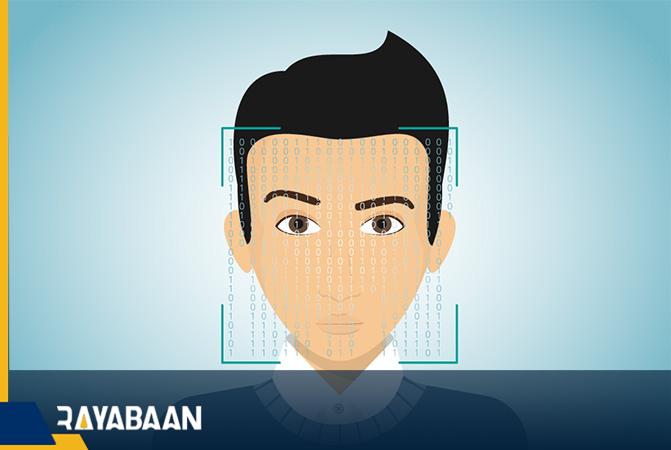
How does facial recognition work on phones
Before we get into the deep layers of this technology, it is important to understand the working process of this technology. In the following, we will introduce three different applications for facial recognition and provide a brief and simple explanation of how they work:
- Common face recognition used in Animoji and Instagram filters. Your phone’s camera looks for a volume similar to a human face; A volume that has two eyes, one nose, and one mouth. Then, using relatively complex algorithms, it tries to recognize the direction of the face and even see if the person’s mouth is open or not. It is not bad to point out that such software is not responsible for face recognition and only looks for human faces.
- Face ID and similar software take a photo of your face and determine how far each part of your face is from the other. Then, whenever you want to open your phone, this application checks whether the distance between the elements of your face is the same as in the original photo. If matched, the phone will be unlocked.
- Recognition of a stranger’s face is generally done in large security companies. In these organizations – in order to maintain security or even for advertising purposes – an effort is made to compare each person’s face with a large number of pre-stored faces in a rich database. This process is very similar to Apple’s Face ID but on a larger scale. On paper, any database (national card database, Facebook account, etc.) can be used for this purpose, but the most ideal option is to use a database of clear images of people’s faces.
Now it’s time to make the discussion a little more complicated. Recognizing the face used in the Instagram filter is very simple and it can be said that the process does not harm people. In this article, we intend to focus on facial recognition and technologies that can be used to identify people.
Most face recognition uses two-dimensional images
As you might expect, most facial recognition software focuses on 2D images. Of course, this issue is not because of the more accurate processing of two-dimensional images, but because of the ease of work. Most of the cameras are used to record images without depth, and on the other hand, the images stored in large databases are mainly two-dimensional.
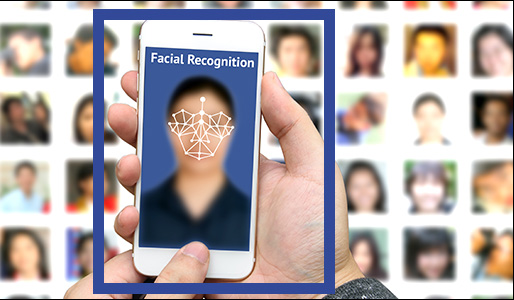
You may ask why facial recognition using two-dimensional images is not 100% accurate. The main reason is that completely smooth and two-dimensional images of the face destroy some important elements that make people’s faces unique. In the two-dimensional image, the computer can only detect the distance between the pupils of the eyes or the width of the lips and mouth, while it is not possible to check the length of your nose or the prominence of your forehead.
In addition, facial recognition using two-dimensional images relies heavily on the presence of sufficient light. This means that you will probably have trouble unlocking your phone in the dark. This can happen even in the shadows.
It is clear that face recognition using 3D images should be used to solve these problems. But the main question here is what should be done to recognize a 3D face? Do we need a special tool?
IR cameras add depth to your images
As we said, most cameras use two-dimensional images for face recognition, but some others have gone to three-dimensional images. In fact, your experience with facial recognition technology has been done to some extent with the help of 3D imaging.
This is done with the help of a technique called lidar, which is very similar to sonar. Sonar is a system for detecting objects under the water’s surface. In this method, sound pulses are sent underwater to hit objects and then return to the sender. According to the travel time of the sound pulse, the depth of underwater objects can be detected.
Lidar is very similar to sonar, except that instead of sending sound pulses, it uses a laser. For example, devices like the iPhone shine an IR matrix on your face, which of course will not harm you. This matrix (which is a wall of lasers) hits your face and then returns to the phone’s sensors and is received by the IR cameras. This will detect the depth of different elements of your face.
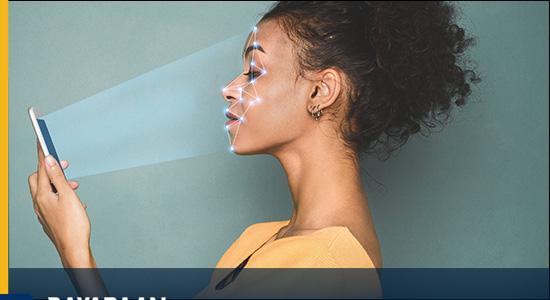
In fact, the IR camera checks the time it takes for each of the lasers to hit your face and return to the phone. It is normal for the light returned from the tip of your nose to return faster than the light that hits your ears. This information helps the phone create a unique image of your face. It is clear that this method is much more accurate compared to two-dimensional face recognition.
Thermal imaging helps to recognize faces in the dark
One of the problems of two-dimensional face recognition is that it faces problems if there is not enough light. But this problem can be solved using thermal imaging.
You might mention that “thermal imaging uses IR light”. This is absolutely correct, but cameras equipped with thermal imaging do not send IR light; They only detect IR light emitted by objects.
Hot objects emit a large amount of IR light, while this amount is very small in cold objects. Expensive thermal cameras can even detect very small temperature differences between different surfaces. That is why this technology can be suitable for facial recognition.
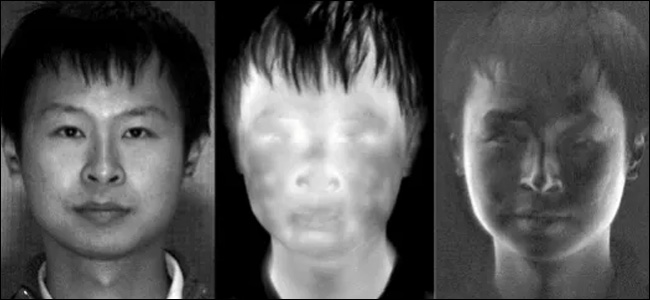
There are many different ways to recognize faces using thermal imaging. Of course, all these techniques are complex, but they have significant fundamental similarities. For this reason, we try to explain them in the simplest possible way:
- To recognize the exact face, it is not enough to record only one image. A thermal camera captures multiple images of surfaces. Each photo focuses on a specific amount of IR light (longwave, shortwave, and normal). Naturally, long waves will define the most details of the face.
- To recognize a more accurate face, the exact location of the body’s veins can be used. These IR images can detect the composition and exact location of the veins inside the person’s face. This makes each person’s face unique like a fingerprint. This method can even be used to detect scars on the face and the distance between facial organs.
- After different imaging, the subject can be recognized. In fact, a volume of different received images is recorded. Then the said volume can be compared with a rich database of faces. By doing this, we will be able to recognize the subject.
Of course, the use of thermal cameras is only for military purposes and you cannot expect that phones will be equipped with it in the near future. After all, this method is mainly used at night without light, and it is not logical to use it during the day. Therefore, it can be said that it will not have any significant use except for military purposes.
Face recognition limitations
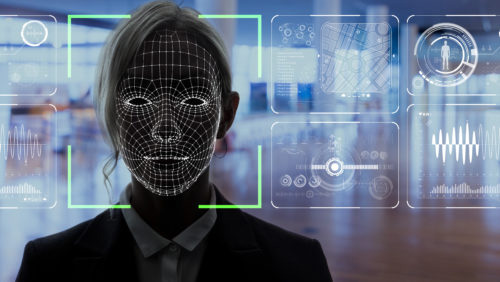
In this article, various issues related to the weaknesses of facial recognition were mentioned, which can be partially resolved by using new methods. But there are some limitations, at least not yet solved:
- Disturbing things: As you probably know, wearing things like sunglasses can make facial recognition difficult.
- Different poses: Face detection technology works best when the subject is looking directly at the camera with a normal face. Performing various gestures and even turning the head can be somewhat problematic for software that uses IR cameras. Additionally, a smile, puffy cheeks, or any other specific gesture can make even the strongest face recognizers have trouble measuring your facial features.
- Light: All different forms of facial recognition are done under a light, and in fact, without light, this technology will not function properly. Of course, this may change soon because researchers are trying to use sonar technology for facial recognition.
- Database: Face recognition cannot perform well without a proper database. In fact, if there is no rich and complete database of people’s images along with their information, facial recognition technology will only watch new people’s faces.
- Data processing: Due to the size and shape of the database, computers may need a lot of time to recognize faces. Sometimes – for example in security cases – this limitation can be problematic.
Applications for face recognition on the phone
As you read in the article, in order to be more accurate, face recognition technology needs to use new hardware in addition to software issues and the use of strong algorithms. But there are some applications that have a good performance in the field of face recognition.
In the following, we will introduce some software in this field. It should be noted that the software you see below is third party and you can download and use them on your phone.
AppLock
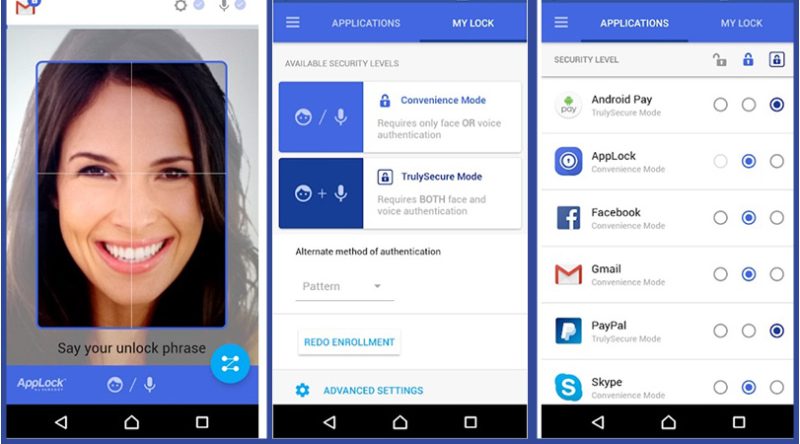
Software that not only recognizes the identity based on the face but also based on the voice. This software is produced by “Sensory Truly Secure” and can help your phone’s security. By using you can encrypt your software on the phone. As soon as someone wants to use it, the phone will try to recognize their face and then ask for a voice command. This application is completely free.
AppLock Face/Voice Recognition
True Key
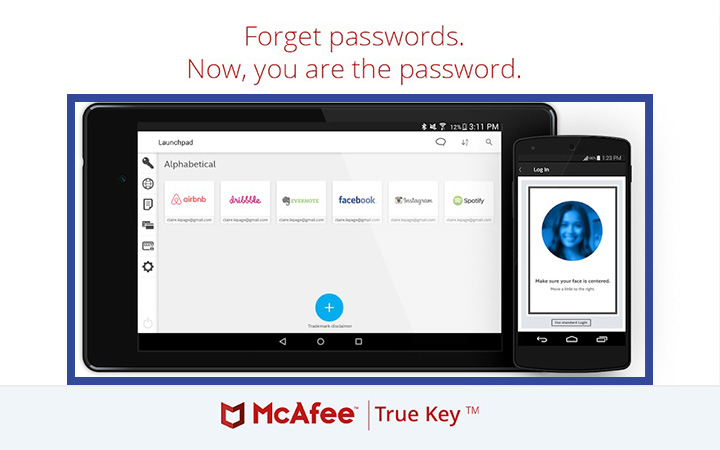
McAfee Company is a well-known name in the field of security that has been working for many years. The True Key application was developed by this famous company and allows users to make their applications more secure than before. With this software, face recognition must be done before entering any of the applications installed on the phone. You can also add pictures of people you trust to True Key.
True Key™ by McAfee
How does facial recognition work on iPhone
Facial recognition technology has come a long way in recent years, and it has become a key feature in many of today’s mobile devices. One of the most popular devices that use facial recognition technology is the iPhone. But how does facial recognition work on the iPhone, and what are the benefits and concerns of this technology? In this article, we will explore these questions in depth, while also adhering to important SEO principles.
What is Facial Recognition on iPhone?
Facial recognition on the iPhone is a biometric authentication technology that allows users to unlock their devices and access certain features by using their face as a password. The technology uses the device’s front-facing camera and a sophisticated algorithm to capture and analyze the user’s facial features, such as the shape of their eyes, nose, and mouth, and create a unique facial map or “biometric template” that is stored on the device.
When the user tries to access their device, the camera captures a real-time image of their face, and the algorithm compares it to the stored biometric template to determine if the user is the owner of the device. If the facial features match, the device is unlocked, and the user can access their apps and data.
How Does Facial Recognition Work on iPhone?
Facial recognition technology on the iPhone is powered by Apple’s TrueDepth camera, which is a sophisticated system that consists of a dot projector, an infrared camera, and a flood illuminator. The dot projector projects a grid of 30,000 invisible dots onto the user’s face, while the infrared camera captures an image of the face that is reflected back by the dots. The flood illuminator provides infrared light to illuminate the face and make it visible to the camera.
Once the camera captures an image of the face, the TrueDepth camera’s neural engine uses machine learning algorithms to create a mathematical model of the user’s face. This model is stored in the Secure Enclave on the device, which is a hardware-based security feature that is separate from the main processor and is designed to protect sensitive data.
The mathematical model of the user’s face is not a photograph or a video but a series of numbers that represent the unique features of the face, such as the distance between the eyes, the shape of the nose, and the contours of the face. When the user tries to unlock their device, the camera captures another image of their face, and the mathematical model is compared to the new image to determine if the features match.
Benefits of Facial Recognition on iPhone
Facial recognition technology on the iPhone offers several benefits to users, including convenience, security, and accessibility. One of the main benefits of facial recognition is that it eliminates the need for a password or PIN, which can be difficult to remember and easy to forget. Instead, users can simply look at their device to unlock it, which is much more convenient and faster.
Another benefit of facial recognition is that it is more secure than traditional passwords or PINs. Since facial recognition uses biometric data, which is unique to each individual, it is much harder for someone else to unlock the device using their face. In addition, the mathematical model of the face is stored securely on the device and cannot be accessed by anyone else, which further enhances the security of the device.
Facial recognition technology also offers accessibility benefits to users who may have difficulty typing in a password or remembering a PIN. For example, users with physical disabilities or visual impairments may find it easier to use facial recognition to unlock their devices.
Concerns about Facial Recognition on iPhone Despite the many benefits of facial recognition on the iPhone, there are also some concerns about the technology. One of the main concerns is privacy. Since facial recognition uses biometric data, there is a risk that this data could be hacked or stolen by cybercriminals, who could then
use it for fraudulent activities. There is also a concern that facial recognition could be used for surveillance purposes, as it could potentially be used to track individuals without their knowledge or consent.
To address these concerns, Apple has implemented several security and privacy measures to protect users’ biometric data. For example, the mathematical model of the face is stored securely on the device and cannot be accessed by anyone else, not even Apple. In addition, the TrueDepth camera uses infrared light to capture images of the face, which makes it more difficult for someone to spoof the system using a photograph or video of the user’s face.
Another concern about facial recognition on the iPhone is accuracy. While the technology is generally very accurate, there have been some reports of false positives and false negatives. For example, facial recognition may fail to recognize a user’s face if they are wearing a hat, glasses, or a face mask. In addition, the technology may mistakenly identify someone else as the owner of the device if they have similar facial features.
To improve accuracy, Apple regularly updates its facial recognition technology with new algorithms and machine learning models. In addition, users can train the system to recognize their faces better by using the “Face ID & Passcode” settings on their device and following the prompts to reposition their faces or move their heads slightly.
Conclusion
Facial recognition technology on the iPhone is a powerful tool that offers many benefits to users, including convenience, security, and accessibility. The technology is powered by Apple’s TrueDepth camera, which uses a sophisticated system of sensors and algorithms to capture and analyze the user’s facial features and create a unique biometric template. While there are some concerns about privacy and accuracy, Apple has implemented several security and privacy measures to protect users’ biometric data and regularly updates its facial recognition technology to improve accuracy and reliability.
In conclusion, facial recognition technology on the iPhone is a valuable feature that can enhance the user experience and provide greater security and accessibility. By understanding how the technology works and being aware of the potential benefits and concerns, users can make an informed decision about whether or not to use facial recognition on their devices.
Frequently asked questions about how doas facial recognition work
- What is facial recognition?
Facial recognition is a technology that identifies or verifies a person’s identity using their facial features.
- How does facial recognition work?
Facial recognition works by analyzing a person’s facial features, such as the distance between their eyes, the shape of their nose, and the contours of their face, to create a unique biometric template. This template is then compared to a database of known faces to identify or verify the person’s identity.
- What are the types of facial recognition?
There are three types of facial recognition: 1) 2D facial recognition, which analyzes a 2D image of a person’s face; 2) 3D facial recognition, which analyzes a 3D image of a person’s face; and 3) thermal imaging facial recognition, which uses thermal cameras to capture and analyze a person’s facial heat signature.
- What are the applications of facial recognition?
Facial recognition is used for a variety of applications, including security and surveillance, law enforcement, border control, access control, and personal device authentication.
- What are the benefits of facial recognition?
The benefits of facial recognition include increased security, improved efficiency, and conveniences, such as being able to unlock your phone or access a secure location without the need for a physical key or password.
- What are the concerns about facial recognition?
There are concerns about facial recognition’s potential to invade privacy, discriminate against certain groups of people, and lead to false identifications. There are also concerns about the accuracy of facial recognition technology and the potential for it to be misused.
In this article, we talked about “How does facial recognition work” and we are waiting for your experiences to use these methods. Please share your thoughts with us.

